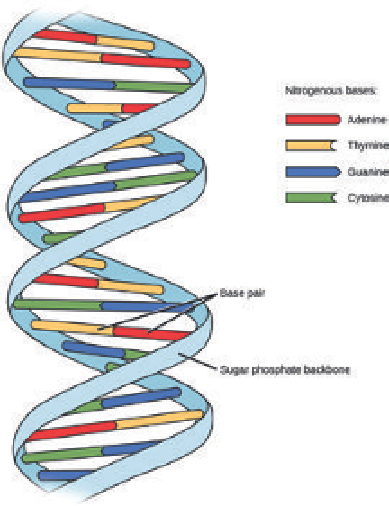Information Technology Reference
In-Depth Information
Fig. 15.21. Illustration of the double
helix of the DNA molecule.
a chromosome contains many such genes. The Human Genome Project esti-
mated that humans have between twenty thousand and twenty-five thousand
genes stored in twenty-three pairs of chromosomes. Thus a cell stores a giga-
byte of genetic information in a volume as small as about a millionth of a cubic
millimeter (
Fig. 15.22
).
Understanding the genetic basis of cells means that it is possible in prin-
ciple to manufacture a DNA sequence to order and produce a synthetic ver-
sion of a cell's genome. In 2010, researchers at the J. Craig Venter Institute in
Rockville, Maryland, announced the creation of the first synthetic life form,
a self-replicating bacterial cell (
Fig. 15.23
). The team synthesized the genome
of an existing bacterium consisting of more than one million base pairs and
inserted this synthetic genome into a different bacterium with its own genome
removed. The new genome took over the cell's machinery, changing the cell's
appearance and behavior, and the modified cell was able to divide and multiply.
To prove that the cell's genome was artificially manufactured, the Venter group
inserted four markers into the DNA sequence. The markers included the names
of the researchers; a paraphrased quotation from Richard Feynman, “What I
cannot create, I do not understand” (words found on his blackboard after he
died); and a message congratulating the decoder.
The first use of DNA in computing was an experiment performed by Len
Adleman, whom we met earlier in the discussion of the RSA encryption scheme.
Adleman invented a way of using single-stranded DNA - one side of a DNA lad-
der with its sequence of bases not paired with a partner DNA strand - to solve
a puzzle called the
seven-city directed Hamiltonian path problem
, a variation of the
traveling salesman problem we discussed in
Chapter 5
. To solve a seven-city
directed Hamiltonian path problem, you must find the shortest route between
seven cities, beginning at one designated city and ending at another, passing
through each of the other five cities exactly once. In Adleman's experiment,
a single strand of DNA represented each city, with a corresponding unique
Fig. 15.22. Researchers at the University
of California, San Diego, genetically
engineered bacteria to glow and blink in
unison, acting as a tiny “neon” sign.
Fig. 15.23. The first self-replicating
synthetic cells from the J. Craig Venter
Institute.



Search WWH ::

Custom Search